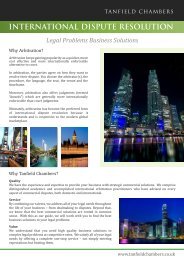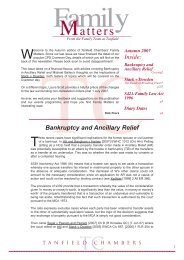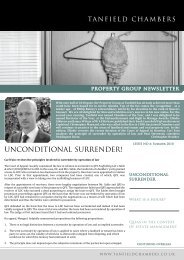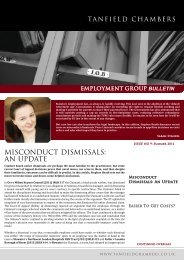Link to newsletter - Tanfield Chambers
Link to newsletter - Tanfield Chambers
Link to newsletter - Tanfield Chambers
- No tags were found...
Create successful ePaper yourself
Turn your PDF publications into a flip-book with our unique Google optimized e-Paper software.
TA N F I E L D C H A M B E R Sproperty group <strong>newsletter</strong>Since the last <strong>newsletter</strong>, the strength of the Property Group has grown. We are delighted <strong>to</strong> announcethat Kerry Brether<strong>to</strong>n formerly of Hardwicke <strong>Chambers</strong> is joining <strong>Chambers</strong>. Kerry’s practice, withregular appearances in the Court of Appeal, her appearance in the Supreme Court in Mexfield HousingCo-operative v Berrisford, and her recent appointment <strong>to</strong> the At<strong>to</strong>rney General’s A Panel, will add <strong>to</strong> therange and quality of service that <strong>Tanfield</strong> provides. We also welcome two junior members, Sara Lewisand Niraj Modha, and a new clerk, Luke Faulkner, who will be assisting Joanne Meah. In other news,Mark Loveday has won Barrister of the Year at the Property Management Awards, and James Fieldsendhas co-authored a new book, Commercial Property Litigation.In this issue, Daniel Dovar surveys restrictions on forfeiture of residential leases, Andrew Butlercomments on the new dilapidations pro<strong>to</strong>col, and Kerry Brether<strong>to</strong>n considers statu<strong>to</strong>ry appeals forparking crossovers.Cecily CrampinEnd of Term FormalitiesSince 1 January 2012 a new pre-action pro<strong>to</strong>col has been in force, governing claims for endof term dilapidations in commercial tenancies. Like other pre-action pro<strong>to</strong>cols, paragraph1.5 provides that a Court “is not likely <strong>to</strong> be concerned with minor or technicalshortcomings” but will look at departures of substance from it.First stepsThe first step is for the landlord <strong>to</strong> send the tenant a Schedule of Dilapidations not later than 56 daysafter termination, and preferably electronically. Two forms are provided (Annexes B and C) dependingon whether completion is by the landlord or his surveyor. The difference lies in the nature of theendorsement; in either case however, and in deference <strong>to</strong> the cap on damages contained in s.18(1)Landlord & Tenant Act 1927, the endorsement involves certifying that account has been taken of thelandlord’s intentions at termination, as well as that the works, and prices, are reasonable.Within the same period, the landlord should also serve a Quantified Demand setting out thecompensation sought. The Pro<strong>to</strong>col makes no provision for a diminution in value calculation at thisstage; that follows the negotiation stage if no settlement has been reached.In contrast <strong>to</strong> the provisions regarding the Quantified Demand, which is expressly stated not <strong>to</strong> havethe status of a statement of case (para.4.1), there is no corresponding statement about the Schedule.Does this omission mean that the Schedule is <strong>to</strong> be treated as equivalent <strong>to</strong> a statement of case? It issuggested that it should not be. A deliberately false endorsement will not therefore be a contempt.Nevertheless, it is clear that the endorsement is meant <strong>to</strong> be formal, and a false one could, quite apartfrom any disciplinary sanctions for a professional involved, lead <strong>to</strong> the vitiation of any compromisebased on it. If no compromise is reached and litigation follows, an exaggerated Schedule could alsosound in costs.ISSUE NO 9: WINTER 2012Dilapidationspro<strong>to</strong>colResidential forfeitureParking crossoverscontinued overleafW W W. T A N F I E L D C H A M B E R S . C O . U K
ANDREW BUTLERAndrew Butler‘s property practice covers a widerange of disciplines, from the core areas ofmortgagee and landlord and tenant claims <strong>to</strong> lessmainstream matters such as construction disputesand property-related professional negligence. Hiscurrent case-load includes a £2.6m claim against avendor and structural engineer relating <strong>to</strong> defects ina property, and an attempt by long leaseholders in aprestigious London square <strong>to</strong> participate in development by the exercise of theirrights as minority shareholders.Ranked in the Legal 500 and <strong>Chambers</strong> & Partners for his Real Estate work,Andrew is described in one recent direc<strong>to</strong>ry as “a very charming guy with arelaxed style that works well with clients and judges”. While rarely feeling eithercharming or relaxed, he is happy if clients and judges see things otherwise.Andrew spends much of his time away from work ferrying around his two youngchildren and engaged in a sporting career of an increasingly (but not yet fully)armchair nature.The Tenant’s ResponseThe tenant is required <strong>to</strong> respond <strong>to</strong> the Quantified Demand within thenext 56 days, where appropriate using the Schedule. The wording ofthe endorsement on this Response follows the wording of thelandlord’s endorsement, with the difference that the tenant or hissurveyor (who obviously cannot know what the landlord’s intentionsfor the property are) is required only <strong>to</strong> say that he has taken accoun<strong>to</strong>f what he “reasonably believes” those intentions <strong>to</strong> be.Presumably if a tenant does not respond, the landlord could issueproceedings without further compliance, but it might be wise for himstill <strong>to</strong> provide a Quantification of Loss (see below).Disclosure and NegotiationPre-action disclosure, often a problem in dilapidations disputes, isdealt with in para.6 which expressly limits disclosure <strong>to</strong> “the documentsrequired <strong>to</strong> be disclosed with the Quantified Demand and the Tenant’sResponse” – in other words, any invoices or detailed estimates (seepara.4.3) and material on which the tenant or his surveyor relies inconsidering that items of disrepair have been superseded by thelandlord’s intentions (para.5.6.2). These should be disclosed with theQuantified Demand and the Response respectively.The next stage is Negotiation. Meetings should take place within 28days of the Response. The parties are encouraged <strong>to</strong> consider ADR andare expressly warned at this stage (para.8.1) that the court will takein<strong>to</strong> account the extent of compliance when making orders about costs.Confusingly however, para.8.3 then contains express recognition that“no party can or should be forced <strong>to</strong> mediate or enter in<strong>to</strong> any form of[ADR]”.From Quantification of Loss <strong>to</strong> the issue ofproceedingsThe final stage of the process is for the landlord, “prior <strong>to</strong> issuingproceedings”, <strong>to</strong> send a “Quantification of Loss”, which consists of a“detailed breakdown of the issues and consequential losses based on aformal diminution valuation or an account of the actual expenditure”.The implication is that where the work has been done, a diminutionvaluation may not be required.If the tenant relies on a defence based on diminution, he shouldprovide a valuation within a further 56 days. This is, it is suggested,poorly thought through; a landlord may not know whether the tenantwill run such a defence and will be left uncertain whether he is free <strong>to</strong>commence proceedings after service of the Quantification of Loss.Nevertheless, the Pro<strong>to</strong>col does also require a “S<strong>to</strong>cktake” at the end ofthe process. A landlord might be prudent <strong>to</strong> wait 56 days before issuingproceedings unless there are good reasons not <strong>to</strong> do so. If within thattime the Tenant sends a valuation, a further period of reflection shouldfollow.andrew butlerour authorsTCReservations on forfeiIn 2006, The Law Commission stated:The law of forfeiture is in urgent need of reform … It is complex, itfor its abolition and its replacement by a simpler, more cohproportionate in the circumstances.This reflected a growing distaste for an old law that can operate harshlyon tenants. Despite this, there has not been much momentum forlegislative change. In the meantime, forfeiture of residential premises istangled with statu<strong>to</strong>ry intervention. Modern legislation seeks <strong>to</strong> protecttenants from losing what is both their home and probably their mostvaluable asset.Relief and service chargesSection 146 of the Law of Property Act 1925 places obstacles between thelandlord and forfeiture. In all cases except non-payment of rent, alandlord must serve a section 146 notice on the tenant before forfeiting.This certainly includes a failure <strong>to</strong> pay service charges not reserved asrent.What of the situation when the service charge is reserved as rent orpayable as additional rent? Nourse LJ in Escalus Properties v.Robinson [1996] QB 231, CA, a case concerning whether, under s138 ofthe County Courts Act 1984, a tenant was entitled <strong>to</strong> au<strong>to</strong>matic relief fromforfeiture where the service charge was payable as additional rent, statedthat where the terms of the lease provide that the service charge shouldbe so payable, it “invests the charge with the character of rent”:Rent [is] (i) a periodical sum, (ii) paid in return for the occupation of land,(iii) issuing out of the land, (iv) for non payment of which distress is leviable… [The] leases, by providing that service charge should be deemed <strong>to</strong> besums due by way of additional rent, had the effect of conferring the likeattributes on the service charge ...If the service charge had been a service charge and nothing more, thenrelief would have been discretionary under section 146(2). The court wasdetermining whether or not the service charges were rent in the contex<strong>to</strong>f both s138 and s146; if it was rent, then under s146(11), s146 was notapplicable.service charges are service charges, even if reservedas rentA service charge reserved as rent is not invested with the character ofW W W. TA N F I E L D C H A M B E R S . C O . U K
DANIEL DOVARDaniel has now been with <strong>Tanfield</strong> for almost a yearand since joining, as well as continuing <strong>to</strong> develophis property practice (which has included asuccessful boundary dispute over a castle wall inWales) he has managed <strong>to</strong> write some articles, add adaughter <strong>to</strong> his family and be appointed a Chairmanof the Residential Property Tribunals.In what is shaping up <strong>to</strong> be a busy year, Daniel will find himself arguing overmany types of leases, occupational rights and property valuations, walkingacres of disputed areas of land and getting stuck in<strong>to</strong> an enormous professionalnegligence property dispute. He also has <strong>to</strong> get the proofs in for the next editionof Residential Possession Proceedings (9th Edition published by Sweet andMaxwell) and will try and write a few articles and give some lectures along theway.Kerry Brether<strong>to</strong>nKerry Brether<strong>to</strong>n joins the Property Group as anestablished Property practitioner, will augment<strong>Chambers</strong>’ work in Public Law having beenappointed <strong>to</strong> the At<strong>to</strong>rney General’s A Panel, andwill continue her interest in costs-only cases.Kerry has appeared in the Supreme Court andfrequently appears in the Court of Appeal,Administrative Court and Court of Protection, oftenacting against Leading Counsel. The Legal 500 ranks Kerry in the Propertysection as “very knowledgeable” and previously described her as “excellen<strong>to</strong>n her feet”. Kerry is ranked in Band 1 in <strong>Chambers</strong> & Partners for SocialHousing, and is described as “tenacious, and someone whose advice isalways clear and concise. If you have a <strong>to</strong>ugh case and you need a battler, sheis the one". She is "excellent with clients." Ongoing work includes acommercial forfeiture case in which Kerry succeeded with indemnity costsagainst the direc<strong>to</strong>rs of the lessee; they are seeking permission <strong>to</strong> appeal.Kerry’s loves travelling, and the theatre but, most of all, her 3 step-childrenwho keep her on her <strong>to</strong>es even more than any member of the judiciary.turelacks coherence, and it can lead <strong>to</strong> injustice. The time has comeerent statu<strong>to</strong>ry scheme based on what is appropriate andrent <strong>to</strong> the exclusion of all else. It will still be a service charge within themeaning of s18 of the Landlord and Tenant Act 1985 since it remains:an amount payable by a tenant of a dwelling as part of or in addition <strong>to</strong> therent …The section explicitly contemplates a service charge being reserved asrent by the use of the words “as part of”, but it also recognises that it willnot be so reserved in every lease by use of the alternative “or in addition<strong>to</strong> the rent”. The section therefore not only accommodates the two waysin which service charges can be considered under a lease, but preservesand reinforces that distinction.There is nothing in section 18 which alters the nature of a service chargereserved as rent for the purpose of s146. It just ensures that in residentialcases, the charge is subject <strong>to</strong> the statu<strong>to</strong>ry protection afforded <strong>to</strong>residential tenants under the 1985 Act. If it were otherwise, then theprovisions of the 1985 Act could be easily circumvented by deeming theservice charge <strong>to</strong> be rent in the lease.There is nothing in s18 which alters the nature of a service chargeeserved as rent for the purpose of s146.”The need for a determinationFurther statu<strong>to</strong>ry provisions s<strong>to</strong>p a landlord from simply heading straight<strong>to</strong> forfeiture for sums demanded by way of service charge. Firstly, s81 ofthe Housing Act 1996 applies <strong>to</strong> service charges of dwellings, whether ornot they are reserved as rent, and prevents a landlord forfeiting for nonpayment of service charge without first obtaining an admission from thetenant or a determination by a tribunal or court.In addition, s168 of the Commonhold and Leasehold Reform Act 2002restricts forfeiture of long leases where a notice needs <strong>to</strong> be served unders146. No such notice can be served without an admission as <strong>to</strong> the allegedbreach or a determination. There is some overlap between the twosections, but a determination under section 81 should be sufficient fors168 by reason of s168(2)(c).Thus, in residential cases, the landlord will have <strong>to</strong> obtain a determinationfrom the court or the Leasehold Valuation Tribunal before he seeks <strong>to</strong>forfeit for non-payment of service charges whether or not they arereserved as rent, unless the amount is admitted by the tenant.The effect of 69 MarinaA recent Court of Appeal case, Freeholders of 69 Marina, StLeonards–on–Sea–Robinson, Simpson & Palmer v John Oram &Mohammed Ghoorun [2011] EWCA Civ 1258, has thrown up somequeries over the steps a landlord must take <strong>to</strong> forfeit for default in thepayment of service charges reserved as rent. In 69 Marina, leases of aresidential building provided that service charges were payable by way ofadditional rent. There was also a covenant <strong>to</strong> pay the expenses of andincidental <strong>to</strong> s146 notices.After reciting section 81 (1) (a) and (b), the Chancellor of the High Court,Sir Andrew Morritt, said at paragraph 12:Subsections (2) and (4A) plainly recognise that the s146 procedure isapplicable in the case of re-entry or forfeiture in the case of non-payment ofa service charge. Given that the definition of service charge includes “anamount … payable as a part of … the rent”, the evident intention is that thes146 procedure, as modified, is <strong>to</strong> be applicable in cases of non-payment ofa service charge even when such charge is recoverable as part of the rent.Further at paragraph 18 he said:continued overleafW W W. TA N F I E L D C H A M B E R S . C O . U K
There is no doubt that the Freeholders incurred costs in the repair of thecommon parts of the Building in performance of their obligation underclause 4(1). That, in turn, created a liability on the tenants, including theLessees, <strong>to</strong> reimburse the Freeholders for those costs under clause 1(b).The amount of that liability comes within the definition of service chargein s18 Landlord and Tenant Act 1985 but cannot be enforced except inaccordance with the terms of s81 Housing Act 1996 and, in the case of along lease, as defined, in accordance with the provisions of s168Commonhold and Leasehold Reform Act 2002 . Each of those sectionsrequires the amount of the tenant's liability <strong>to</strong> have been finallydetermined by the Leasehold Valuation Tribunal. Moreover each of thosesections requires or recognises that even when so determined theenforcement of that liability is subject <strong>to</strong> the provisions of s146 even if thelease treats it as an additional rent recoverable as such. In short theenforcement of the liability of the tenants under clause 1(b) required firstthe determination of the Tribunal and second a s146 Notice.In the first passage, one might consider that his Lordship was statingthat s146 applied and given the exemption of s146(11), no noticeneeded <strong>to</strong> be served when the service charge was reserved as rent.However, by the end of the second passage it seems that the decisionsuggests that s81 of the 1996 Act and s168 of the 2002 Act require inall cases the need for the service of a s146 notice even when the servicecharge is deemed <strong>to</strong> be rent. The decision appears <strong>to</strong> extrapolate froms18 that all services charges must remain that and nothing more for thepurposes of other legislation. Yet, as argued above, s18 recognises thatservice charges can in some cases be reserved as rent and that thesection preserves that distinction.Given the judgment of Nourse LJ in Escalus, it is difficult <strong>to</strong> see howthese two Court of Appeal authorities can be reconciled. Nourse wasclearly endowing the service charge with the qualities of rent.However, it does not appear from the transcript of the judgment thatEscalus was cited in 69 Marina. Nor is it clear what submissions on thisaspect were made.Parking WarsIf an Englishman’s home is his castle, what happens when use of thedrawbridge is prohibited?The London Local Authorities and Transport for London Act 2003empowers the relevant authority <strong>to</strong> serve a notice where an occupierof premises adjoining or having access <strong>to</strong> a highway habitually takes amechanically propelled vehicle, or permits it <strong>to</strong> be taken, across akerbed footway or verge in the highway. In deciding whether <strong>to</strong>enforce, the authority must consider the need <strong>to</strong> prevent damage, <strong>to</strong>ensure safe access, <strong>to</strong> prevent obstruction of the footway, and <strong>to</strong>facilitate the passage of vehicular traffic. Action cannot be taken incertain situations such as established use.There is a procedure for lodging an objection <strong>to</strong> a notice, and theauthority must respond indicating whether the notice will bewithdrawn or not. The recipient of a notice may then proceed with astatu<strong>to</strong>ry appeal <strong>to</strong> the County Court. The County Court has widepowers <strong>to</strong> quash the notice, not just if there is a procedural error, but,also if the requirements in the notice are unreasonable.There is not yet any authority on the question of what might beunreasonable. Much may depend on the particular facts but it appearslikely that the time over which the access has been used, and the levelof risk and impact on those with physical disabilities, pursuant <strong>to</strong> theEquality Act 2010 will always be relevant. It appears highlyimprobable that any human rights argument will assist in relation <strong>to</strong>such an appeal as the Court of Appeal rejected a defence based uponhuman rights in relation <strong>to</strong> similar legislation in s80 of the HighwaysAct 1980 in Patrick J Cusack v London Borough of Harrow [2011]EWCA Civ 1514.Kerry Brether<strong>to</strong>nThis author would argue that there is nothing in either section s81 ors168 which imposes any requirement <strong>to</strong> serve a section 146 notice.S168 simply pre-supposes that a notice needs <strong>to</strong> be served. S81(4A)was introduced by the 2002 Act <strong>to</strong> confirm that when it is necessary <strong>to</strong>serve such a notice, that requirement is preserved and not abrogatedby this section. It is a “for the avoidance of doubt” comment. The use ofthe word “includes” in the section envisages that a notice is not alwaysneeded <strong>to</strong> forfeit.“The decision suggests that s81 and s168 require in all cases serviceof a s146 notice even when the service charge is deemed <strong>to</strong> be rent.”ConclusionNot only is change not on the way (or not soon at least), but the tangleof statu<strong>to</strong>ry regulation of forfeiture has just become a little moreconfusing. Landlords will, after 69 Marina, be uncertain as <strong>to</strong> thecircumstances in which they need <strong>to</strong> serve a s146 notice. A belt-andbracesapproach would now have them serving a notice even when theservice charge was reserved as rent. 69 Marina also has an impact onrelief. If a s146 notice is necessary, then there is no au<strong>to</strong>matic right <strong>to</strong>relief under s138 and the tenant will have <strong>to</strong> rely on the court’sdiscretion under s146. To that extent, the decision may have reducedsome of the protection afforded <strong>to</strong> tenants.daniel dovarA version of this article first appeared in [2012] 16 L & T Rev 23published by Sweet & Maxwell (Thomson Reuters).<strong>Tanfield</strong> <strong>Chambers</strong>’ dedicated conference facilities are readily accessibleby the mobility-impaired. Please contact the clerks <strong>to</strong> agree fees inadvance, whether on a fixed or hourly rate. Feedback on our service is welcomedand should be directed <strong>to</strong> the Senior Clerk, Kevin Moore. A copy of<strong>Chambers</strong> Complaints’ Procedure is available on our website or on request.For further information or <strong>to</strong> instruct a barrister, please contactJoanne Meah (Property Clerk), Luke Faulkner(Assistant Property Clerk) or Kevin Moore (Senior Clerk) onT: +44 (0) 20 7421 5300 or E: clerks@tanfieldchambers.co.ukproperty barristers:Geraint Jones QC (1976)Philip Rainey QC (1990)Paul Staddon (1976)Mark Dencer (1978)Chris<strong>to</strong>pher Coney (1979)Charles Joseph (1980)Mark Loveday (1986)Michael Buckpitt (1988)Chris<strong>to</strong>pher Maynard (1988)Phillip Aliker (1990)Nicholas Isaac (1993)Andrew Butler (1993)Stan Gallagher (1994)Chris<strong>to</strong>pher Heather (1995)Dr Karen Jones (1995)Timothy Polli (1997)James Fieldsend (1997)Daniel Dovar (1997)Piers Harrison (1997)Alejandra Hormaeche (1998)Marc Glover (1999)Ellodie Gibbons (1999)Adrian Carr (1999)Rebecca Cattermole (1999)Carl Fain (2001)Tom Carpenter-Leitch (2002)Tim Hammond (2003)Amanda Gourlay (2004)Andrew Sheftel (2004)Jonathon Up<strong>to</strong>n (2004)Paul Stevenson (2006)Gemma de Cordova (2006)Michael Walsh (2006)Sara Lewis (2007)Cecily Crampin (2008)Niraj Modha (2010)To contact us: T: +44 (0) 20 7421 5300, F: +44 (0) 20 7421 5333, DX: 46 London Chancery Lane, E: clerks@tanfieldchambers.co.ukAddress: <strong>Tanfield</strong> <strong>Chambers</strong>, 2-5 Warwick Court, London, WC1R 5DJ





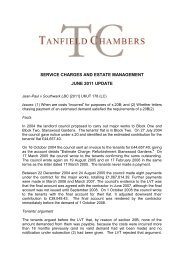
![Re Clarise Properties Ltd [2012] UKUT 4 (LC) - Tanfield Chambers](https://img.yumpu.com/36301708/1/190x245/re-clarise-properties-ltd-2012-ukut-4-lc-tanfield-chambers.jpg?quality=85)



